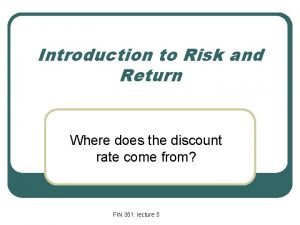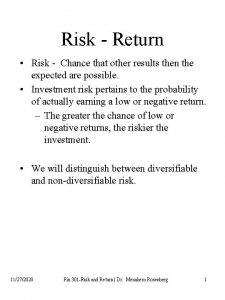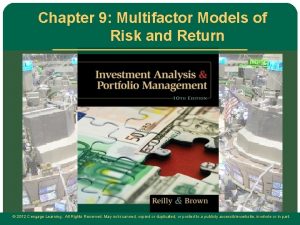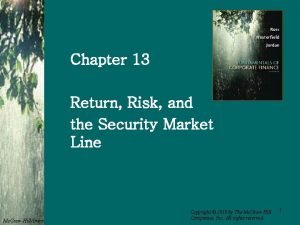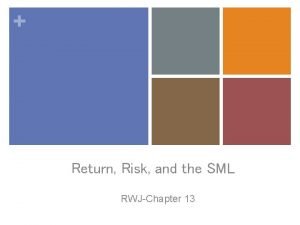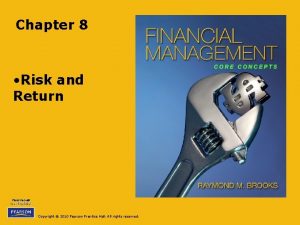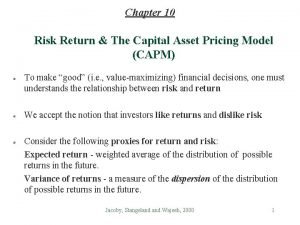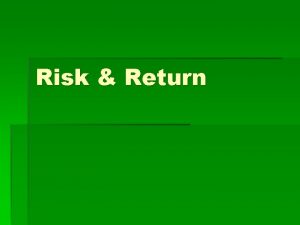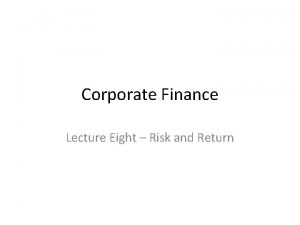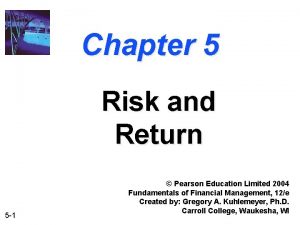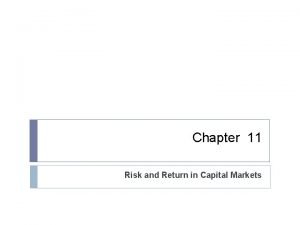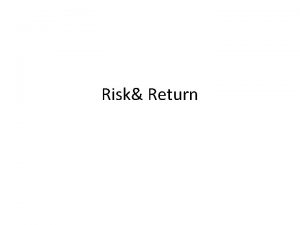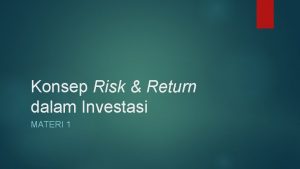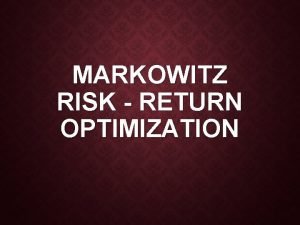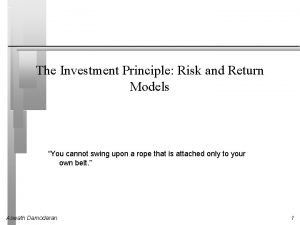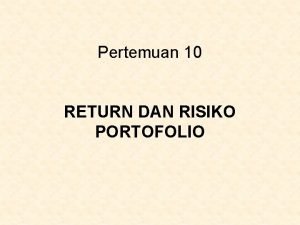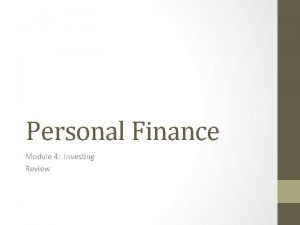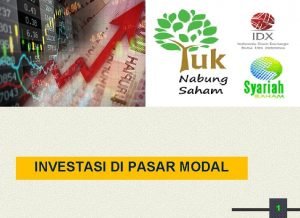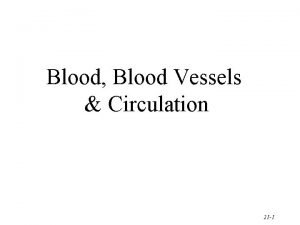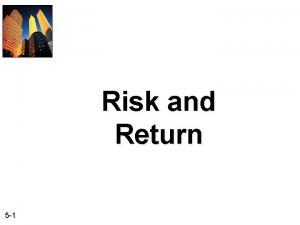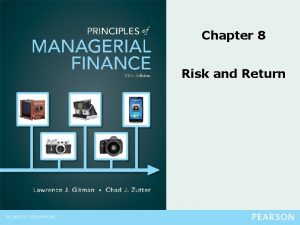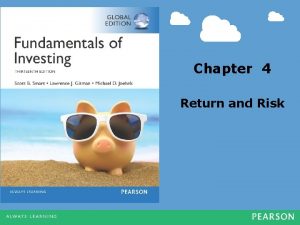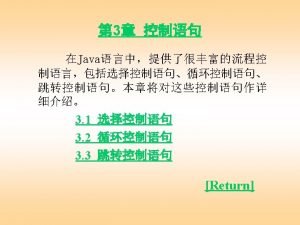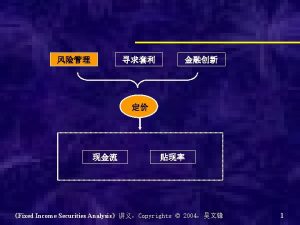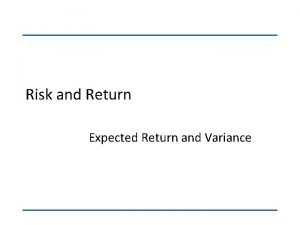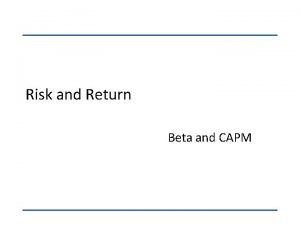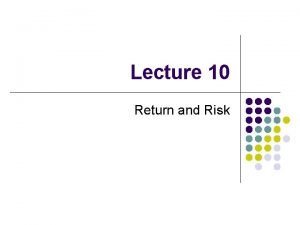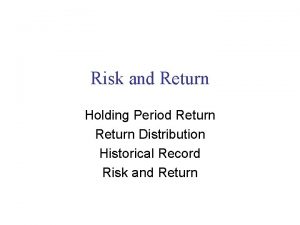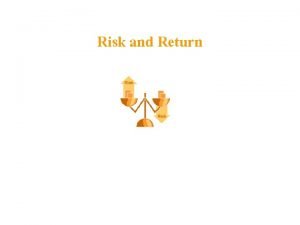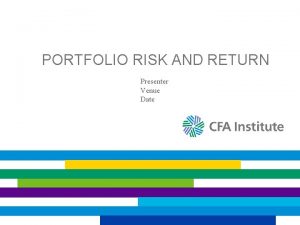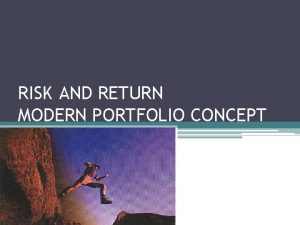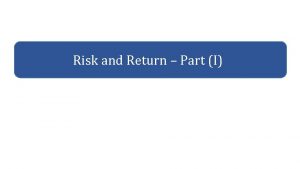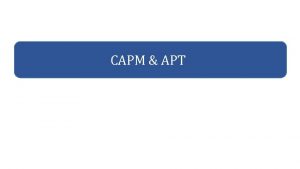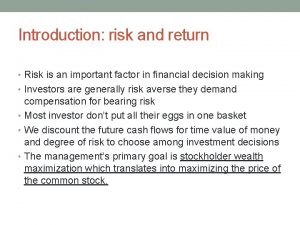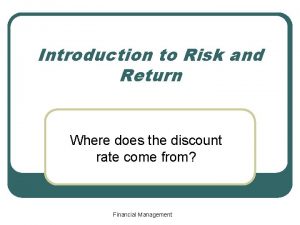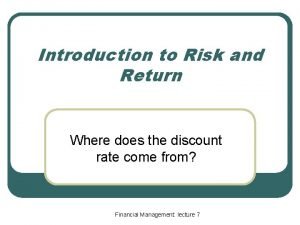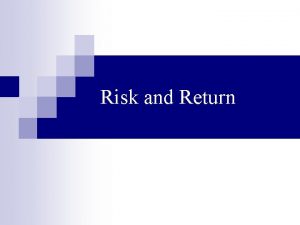Introduction to Risk and Return Where does the












































- Slides: 44

Introduction to Risk and Return Where does the discount rate come from? FIN 351: lecture 5

Today’s plan l Introduction to risk and returns • Rates of Return • 73 Years of Capital Market History • Measuring Risk • Risk & Portfolio Diversification • Measuring systematic risk • The relationship between systematic risk and expected returns FIN 351: lecture 5

How to measure the performance of your investment l Suppose you buy one share of IBM at $74 this year and sell it at the expected price of $102. IBM pays a dividend of $1. 25 for your investment • What profit do you expect to make for your • investment? What profit do you expect to make for one dollar investment? FIN 351: lecture 5

Solution l l Profit in total =102 -74+1. 25=$29. 25 Profit per one dollar=29. 25/74=0. 395 or 39. 5% FIN 351: lecture 5

Rates of Return FIN 351: lecture 5

Rates of Return FIN 351: lecture 5

Rates of Return FIN 351: lecture 5

Rates of Return Nominal vs. Real Suppose that the inflation rate is 1. 6% FIN 351: lecture 5

Market Indexes Dow Jones Industrial Average (The Dow) Value of a portfolio holding one share in each of 30 large industrial firms. Standard & Poor’s Composite Index (The S&P 500) Value of a portfolio holding shares in 500 firms. Holdings are proportional to the number of shares in the issues. FIN 351: lecture 5

The performance of $0. 1 investment FIN 351: lecture 5

Volatility of portfolios Volatility Year FIN 351: lecture 5

Why are stock returns so high? l To invest in stocks, investors require a risk premium with respect to relative risk-free security such government securities. • • • l The expected return on a risky security is equal to the riskfree rate plus a risk premium Expected return =risk-free rate + risk premium Risk premium =expected return –risk-free rate Example • • 23. 3% (1981 on market portfolio)=14%+9. 3% 14. 1% (1999 on market portfolio)=4. 8%+9. 3% FIN 351: lecture 5

How to Measure Risk l l We can use the variance or the standard deviation of the rate of return to measure risk. Variance or standard deviation measures weighted average of squared deviation of each observation from the mean. FIN 351: lecture 5

Some formula l Suppose that there are N states, then the expected rate of return (mean) is l The variance of the rate of return is l The standard deviation FIN 351: lecture 5

Example of risk l Stock A has the following returns depending on the state of the economy next year as follows: State of economy Probability of the state Return rate Good 0. 6 20% Average 0. 3 10% 0. 1 -5% Bad FIN 351: lecture 5

Measure risk (continue) First, calculate the mean return or the expected rate of return. Here N=3 (three states) l Expected rate of return is r-bar= p 1*r 1+p 2*r 2+p 3*r 3=0. 6*0. 2+0. 3*0. 1+0. 1*(-0. 05) =14. 5% l The variance of return is p 1*(r 1 - r-bar)2+p 2*(r 2 - r-bar)2+p 3*(r 3 -r)2 =0. 00625 l The standard deviation is 0. 079=7. 9% l FIN 351: lecture 5

How to measure portfolio risk? l l To measure portfolio risk, we can calculate the variance or standard deviation for the return of the portfolio, as discussed in the previous slide. Most times, we don’t use the approach discussed in the last slide to calculate portfolio risk but use portfolio formula to get it. Before we talk about how to use a different way to calculate portfolio risk, let’s examine some related terms and concepts first. FIN 351: lecture 5

Two types of risks Unique Risk - Risk factors affecting only that firm. Also called “firm-level risk. ” Market Risk - Economy-wide sources of risk that affect the overall stock market. Also called “systematic risk. ” FIN 351: lecture 5

Can we reduce risk? l l Yes, we can reduce risk by diversification: that is, we invest our money in different assets or form a portfolio of different assets. Can we understand intuitively why diversification can reduce risk? FIN 351: lecture 5

Portfolio weights l l Let W be the total money invested in a portfolio, a set of assets. Let xi be the proportion of total wealth invested in asset i. Then xi is called portfolio weight for asset i. The sum of portfolio weights for all the assets in the portfolio is 1, that is, FIN 351: lecture 5

Example l l l You invest $400 of your $1000 in IBM at a price of $74 per share and the other in Dell at a price of $28. What is the portfolio weight for IBM and Dell respectively? Are you sure that you are right? FIN 351: lecture 5

Solution l l l x. IBM=400/1000=0. 4 x. Dell=600/1000=0. 6 x. IBM+x. Dell=1 FIN 351: lecture 5

Some formula for portfolios l The return of a portfolio is the weighted average of returns of the stocks in the portfolio. That is, l The expected return of a portfolio is the weighted average of expected returns of the stocks in the portfolio. That is, FIN 351: lecture 5

Risk and Diversification (example) l John puts his money half in stock A and half in stock B, as shown in the following. l What is the mean and variance of the return of John’s portfolio? FIN 351: lecture 5

My solution l The mean of the return of a portfolio is the weighted average of the returns of the stocks in the portfolio. Thus the mean of the return of John’s portfolio is l The variance of the return of the portfolio is portfolio variance FIN 351: lecture 5

Risk and Diversification FIN 351: lecture 5

Some true or false questions 1. A market index is used to measure performance of a broad-based portfolio of stocks. (True) 2. Long-term corporate bonds are riskier than common stocks. (False) 3. If one portfolio's variance exceeds that of another portfolio, its standard deviation will also be greater than that of the other portfolio. (True) 4. Portfolio weights are always positive. (False) FIN 351: lecture 5

Some true or false questions 5. Standard deviation can be calculated as the square of the variance. (False) 6. Market risk can be eliminated in a stock portfolio through diversification. (False) 7. Macro risks are faced by all common stock investors. (True) 8. The risk that remains in a stock portfolio after efforts to diversify is known as unique risk. (False) 9. We use the standard deviation of future stock prices to measure the risk of a stock (False) FIN 351: lecture 5

Measuring Market Risk l Market Portfolio • It is a portfolio of all assets in the economy. In practice a broad stock market index, such as the S&P 500 is used to represent the market portfolio. The market return is denoted by Rm l Beta (β) • Sensitivity of a stock’s return to the return on the • market portfolio, Mathematically, FIN 351: lecture 5

An intuitive example for Beta Turbo Charged Seafood has the following % returns on its stock, relative to the listed changes in the % return on the market portfolio. The beta of Turbo Charged Seafood can be derived from this information. FIN 351: lecture 5

Measuring Market Risk (example, continue) FIN 351: lecture 5

Measuring Market Risk (continue) l l l When the market was up 1%, Turbo average % change was +0. 8% When the market was down 1%, Turbo average % change was -0. 8% The average change of 1. 6 % (-0. 8 to 0. 8) divided by the 2% (-1. 0 to 1. 0) change in the market produces a beta of 0. 8. β=1. 6/2=0. 8 FIN 351: lecture 5

Another example l Suppose we have following information: Market Stock A bad -8% -10% -6% good 32% 38% 24% State Stock B a. What is the beta for each stock? b. What is the expected return for each stock if each scenario is equally likely? c. What is the expected return for each stock if the probability for good economy is 20%? FIN 351: lecture 5

Solution a. b. c. FIN 351: lecture 5

Portfolio Betas l l Diversification reduces unique risk, but not market risk. The beta of a portfolio will be an weighted average of the betas of the securities in the portfolio. l What is the beta of the market portfolio? l What is the beta of the risk-free security? FIN 351: lecture 5

Example l Suppose you have a portfolio of IBM and Dell with a beta of 1. 2 and 2. 2, respectively. If you put 50% of your money in IBM, and the other in Dell, what is the beta of your portfolio Beta of your portfolio =0. 5*1. 2 +0. 5*2. 2=1. 7 FIN 351: lecture 5

Market risk and risk premium l Risk premium for bearing market risk • The difference between the expected return • • required by investors and the risk-free asset. Example, the expected return on IBM is 10%, the risk-free rate is 5%, and the risk premium is 10% -5%=5% If a security ( an individual security or a portfolio) has market or systematic risk, riskaverse investors will require a risk premium. FIN 351: lecture 5

CAPM (Capital Asset Pricing Model) l The risk premium on each security is proportional to the market risk premium and the beta of the security. • That is, FIN 351: lecture 5

Security market line l The graphic representation of CAPM in the expected return and Beta plane Security Market Line Rm rf FIN 351: lecture 5

Project Risk and cost of the capital l l In capital budgeting, in order to calculate the NPV of the project, we need to measure the risk of the project and thus find out the discount rate (the cost of capital) We can use Beta of the project cash flows to measure the risk of the project and use CAPM to get the expected return required by investors • FIN 351: lecture 5

Example 1 l Based on the CAPM, ABC Company has a cost of capital of 17%. (4 + 1. 3(10)). A breakdown of the company’s investment projects is listed below. • 1/3 Nuclear Parts: β=2. 0 • 1/3 Computer Hard Drive: • 1/3 Dog Food Production: l β =1. 3 β =0. 6 When evaluating a new dog food production investment, which cost of capital should be used and how much? FIN 351: lecture 5

Solution l Since dog food projects may have similar systematic risk to the dog food division, we use a beta of 0. 6 to measure the risk of the projects to be taken. l Thus the expected return on the project or the cost of capital is 0. 04+0. 6*(0. 1)=0. l or 10% FIN 351: lecture 5

Example 2 l Stock A has a beta of. 5 and investors expect it to return 5%. Stock B has a beta of 1. 5 and investors expect it to return 13%. What is the market risk premium and the expected rate of return on the market portfolio? FIN 351: lecture 5

Solution l According to the CAPM FIN 351: lecture 5
 Introduction to risk and return
Introduction to risk and return Credit risk market risk operational risk
Credit risk market risk operational risk Risk and return
Risk and return Risk and return
Risk and return Risk and return
Risk and return Multifactor models of risk and return
Multifactor models of risk and return Financial management chapter 8 risk and return
Financial management chapter 8 risk and return Chapter 13 return risk and the security market line
Chapter 13 return risk and the security market line Risk and return
Risk and return Chapter 8 risk and rates of return problem solutions
Chapter 8 risk and rates of return problem solutions Capital market line
Capital market line Contoh soal security market line
Contoh soal security market line Difference between risk and return
Difference between risk and return Chapter 5 risk and return
Chapter 5 risk and return Difference between risk and return
Difference between risk and return Assume risk and return are positively related
Assume risk and return are positively related Konsep risk and return
Konsep risk and return Markowitz risk return optimization
Markowitz risk return optimization Risk return principle
Risk return principle Rumus risiko portofolio
Rumus risiko portofolio The basic rule of a risk-to-return relationship is that the
The basic rule of a risk-to-return relationship is that the Pengertian investasi
Pengertian investasi Residual risk and secondary risk pmp
Residual risk and secondary risk pmp Business vs financial risk
Business vs financial risk Relative risk
Relative risk Measure of association formula
Measure of association formula Blood vessels
Blood vessels Draw rmmm plan
Draw rmmm plan Risk management avoidance
Risk management avoidance Absolute risk vs relative risk
Absolute risk vs relative risk Inherent risks examples
Inherent risks examples Absolute risk vs relative risk
Absolute risk vs relative risk Activity sheet 3 stock market calculations answer key
Activity sheet 3 stock market calculations answer key Short term risk
Short term risk Pembelanjaan risiko adalah
Pembelanjaan risiko adalah The biggest risk is not taking any risk
The biggest risk is not taking any risk Key risk indicators financial risk management
Key risk indicators financial risk management Business risk vs audit risk
Business risk vs audit risk Risk map risk management
Risk map risk management Hát kết hợp bộ gõ cơ thể
Hát kết hợp bộ gõ cơ thể Bổ thể
Bổ thể Tỉ lệ cơ thể trẻ em
Tỉ lệ cơ thể trẻ em Chó sói
Chó sói Tư thế worm breton
Tư thế worm breton
